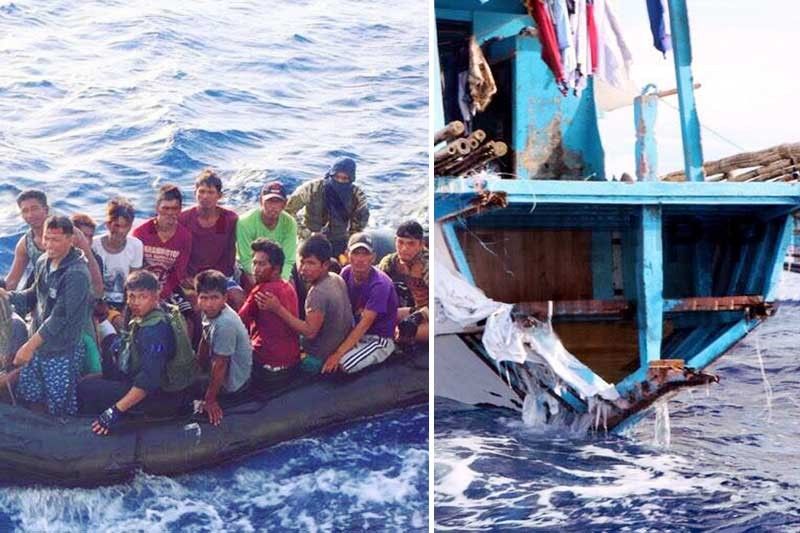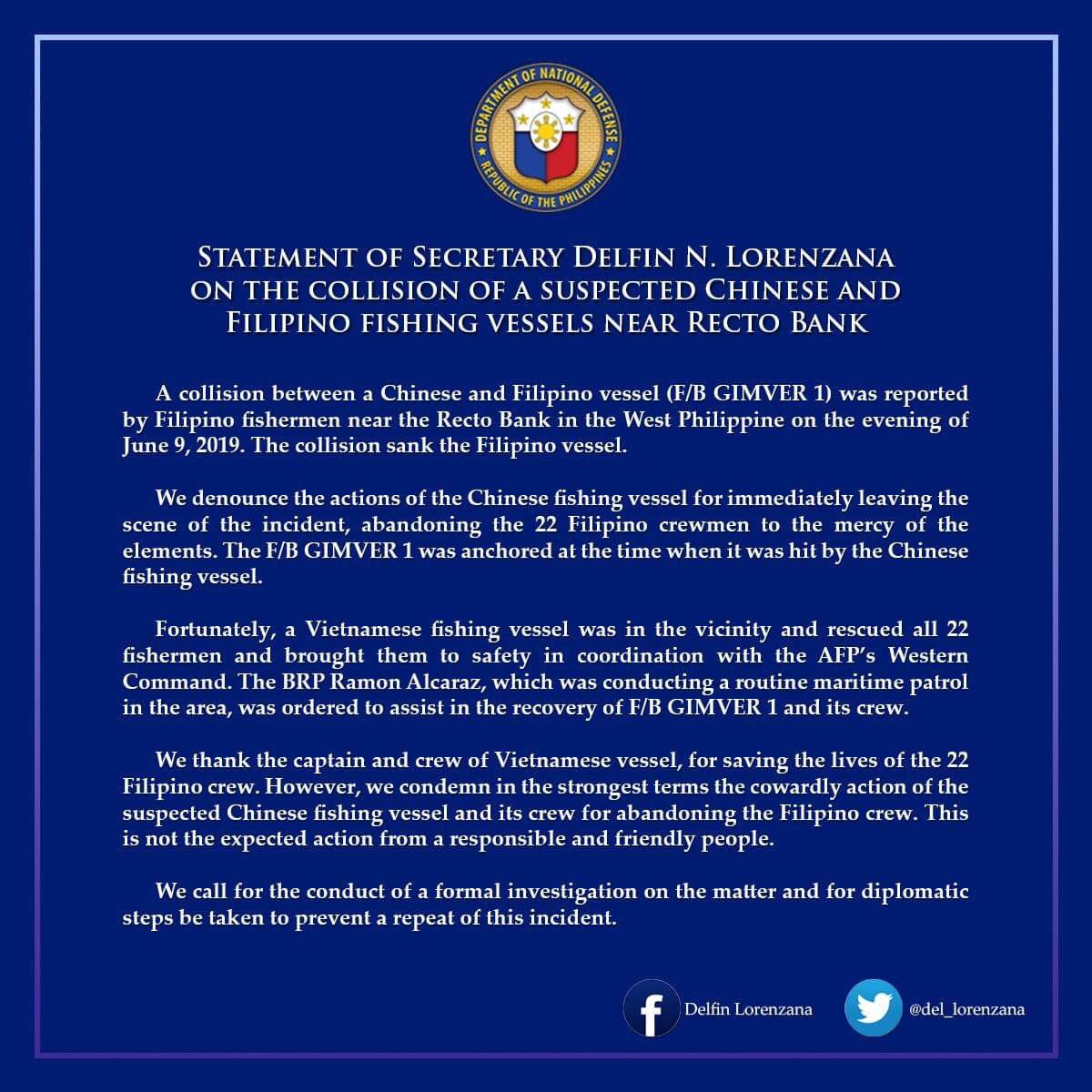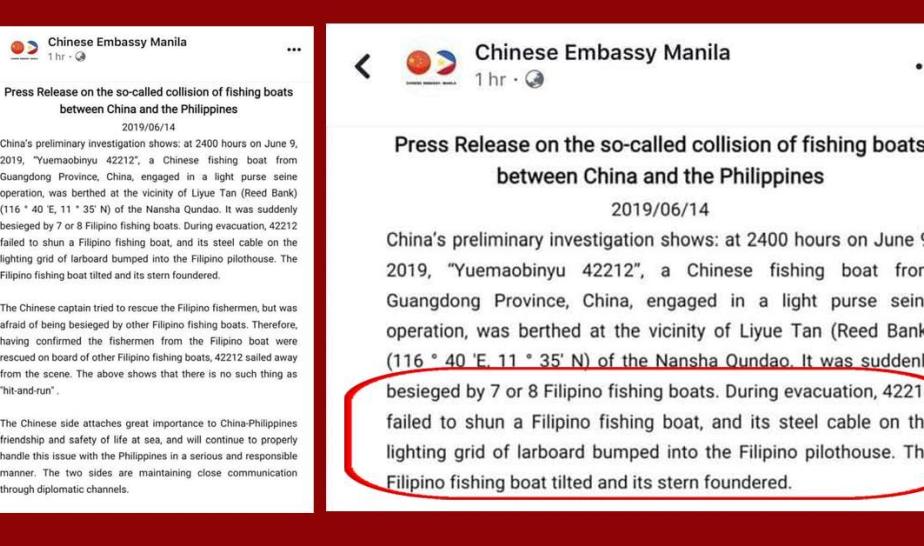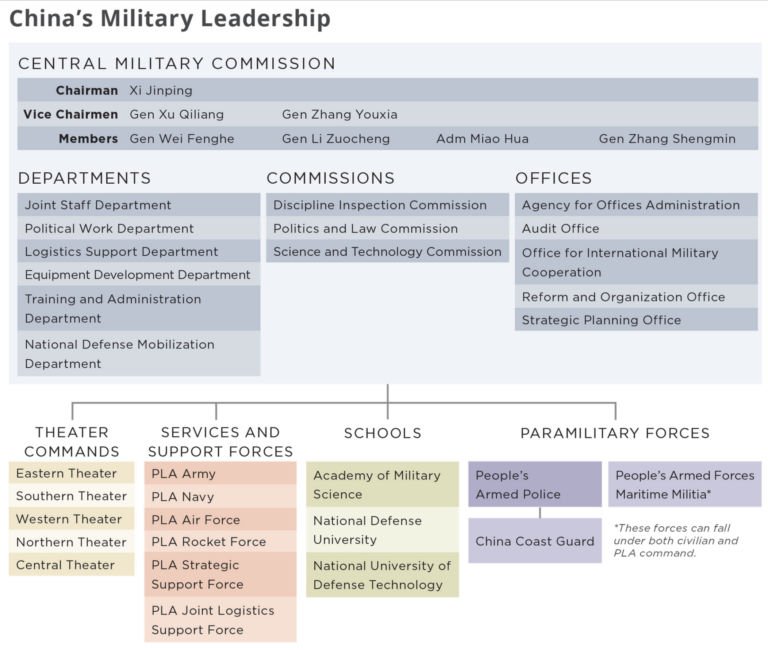Three days before the 121st Independence Day of the Philippines—June 12th, 2019—a Chinese-flagged vessel rammed a Filipino fishing boat in the Philippines’ exclusive economic zone (EEZ) in the West Philippine Sea.
When news of the incident broke, Filipinos took to social media to express their outrage. According to a report published by Business Insider, “The Philippines has accused China of ramming a Philippine fishing vessel, sinking it, and then abandoning the crew to drown in open waters […] The crew of the sunken Philippine vessel was ultimately rescued by a Vietnamese ship operating nearby.”
The Turkish news outlet TRT World reported that Filipinos were angered after a Chinese vessel seemingly rammed a fishing boat in the South China Sea and left its crew to fend for themselves. The New York Times noted that the 22 Filipino fishermen were at sea before being rescued by a Vietnamese boat. The fishermen returned to the Philippines on board the Philippine Navy patrol ship BRP Ramon Alcaraz.

The incident occurred around midnight on June 9th, 2019 in Reed Bank (Recto Bank), 500 kilometers off from the coast of the Philippines. Reed Bank is considered to be a traditional fishing ground for Filipino fishermen and is frequented by fishermen from other countries like Vietnam, China, and Taiwan.
The Visible Infrared Imaging Radiometer Suite (VIIRS) boat detection (VDB) located near the province of Occidental Mindoro revealed that at approximately 1:08 am local time (approximately an hour after the ramming incident), the Yuemaobinyu 422212 detected and allegedly berthed. Meanwhile, the borne-out F/B GEMVIR was transported towards the Caminawit, San Jose port. It also says that five months ago, around January 25th, the Chinese vessel was seen in the area.

A few hours after the news went viral, the Department of National Defense of the Philippines released the following statement:
“A collision between a Chinese and Filipino vessel was reported by Filipino fishermen near the Recto Bank in the West Philippine Sea on the evening of June 9, 2019. The collision sank the Filipino vessel. This is not the expected action from a responsible and friendly people.”
On June 13th, the Foreign Affairs Secretary Teodoro “Teddy” Locsin stated that the Philippines issued a diplomatic protest over the ship-ramming incident in the West Philippine Sea. The country’s top diplomat also described the collision on social media as “contemptible and condemnable.” Locsin’s statement was echoed up by an assessment from the Philippine military’s western command (WESCOM), and Alexander Pama, a former chief of the Philippine Navy, said that there was no doubt that the Chinese vessel had intentionally hit the Philippine boat. Subsequently, the mayor of the town of San Jose in Occidental Mindoro expressed his belief the Chinese vessel had intentionally collided with the Filipino boat.
China released a press release admitting that a Chinese vessel from the province of hit a Filipino vessel in the vicinity of Reed Bank on June 9th. Interestingly, it claimed that the Chinese fishing boat Yuemaobinyu 42212 was “berthed” in the area when seven or eight Filipino fishing boats “besieged” it. Beijing stated that China regards its relationship with the Philippines relationship and the safety of life at sea with high importance and that it would continue to properly handle this issue with the Philippines seriously and responsibly.
China maintained its claim that there was no such thing as a “hit-and-run.” Furthermore, on June 13th, the Chinese foreign ministry spokesman Geng Shuang called the incident “an ordinary maritime traffic accident” and said that China was still investigating the matter. “If the relevant reports are true, regardless of the country from which the perpetrator came from, their behavior should be condemned,” the Chinese official said. Intriguingly, statements were removed from the Chinese Embassy’s social media pages the Friday after the incident but were reposted on the Chinese Embassy’s official Twitter page one day later.

(Screenshot of the Facebook page of the Chinese Embassy Manila Facebook Page on June 14th, 2019)
Philippine Navy chief Vice Admiral Robert Empedrad confirmed that the Chinese vessel which came into contact with a Filipino fishing boat and caused it to sink was no accident, but a deliberate maneuver to ram the smaller craft. Also, Gemvir 1 crewmembers had made it clear that it was a Chinese vessel that rammed their boat and not a Vietnamese vessel, as some officials had insinuated.
According to Junel Insigne, captain of the Filipino vessel, “Umikot muna sila, binalikan kami, sinindi yung maraming ilaw, nung nakita kaming lubog na, pinatay yung ilaw ulit bago umatras, bago tumakbo palayo (They circled us, went back, switched on their lights. When they saw us sinking, they switched off their lights and hurriedly left),” adding he could tell they were Chinese because of the type of ship lights. “Kung wala dun yung Vietnam, baka mamatay na kaming lahat (If the Vietnamese weren’t there, we would have died).”
Moreover, the Navy Chief said at the Maritime Symposium held at The Manila Hotel on June 14th that “The Filipino vessel was anchored. So when based on the International Rules of the Road, it had the privilege because it could not evade […] the ship was rammed. This is not a normal incident. The boat was anchored.” In similar instances, the Armed Forces of the Philippines may assist the relevant government agency in conducting a formal inquiry on the incident, given that it caused the fishermen and the boat owners over 2 million Philippine pesos worth of damages. It included about three tons of fish with an estimated worth of P1 million; P500,000 in capital, and P700,000 for the fishing boat.
Financial assistance was provided one week after the incident occurred. Agriculture Secretary Emmanuel Piñol, through the Agricultural Credit Policy Council (ACPC), released P25,000 for each of the 22 fishermen under the Survival Response (SURE) Loan Program to help them recover losses incurred. Aside from financial assistance, the government, through the Bureau of Fisheries and Aquatic Resource (BFAR), committed to grant the fishermen 30-footer fiberglass boats fully outfitted with engine and nets, in addition to 11 boats—each of which would be shared by two fishermen—in order for them to have a source of additional income while the F/B GEM-VIR 1 is being repaired.
The government also tapped the Philippine Amusement and Gaming Corporation (PAGCOR) for additional funding. The funding will not be limited to assisting the 22 fishermen, but will also be used to buy ice-making machines and cold storage for fishing grounds nationwide. Meanwhile, Vice President Leni Robredo gave P50,000 in financial assistance (under the Angat Buhay Program) to fisherman as she visited them in Mindoro.
Strategic Analysis
The 1951 San Francisco Treaty failed to assign possession of the Spratly Islands when Japan lost its title to them following its defeat in the Second World War. Article 2 states that “Japan renounces all right, title and claim to the Spratly Islands and to the Paracel Islands.”
The Spratly Islands constitutes the chain of 200 islets, coral reefs, and seamounts. Its northern extension, the Paracel Islands, spreads across 250,000 square kilometers of the South China Sea, a vast continental shelf that constitutes a potentially rich source of oil and natural gas. It went further into an international conflict when several claimants began extracting resources from the seabed contiguous to their Exclusive Economic Zones (EEZ) in the mid-70s. China, Taiwan, and four ASEAN states − Brunei, Malaysia, the Philippines, and Vietnam − all laid claim and occupied part of the islands in the South China Sea. The contested ownership over the Spratly Islands continues to be a key point of contention.
Meanwhile, a significant aspect of the territorial dispute in the South China Sea concerns China’s construction in the area. China has engaged in large-scale land reclamation activities in seven reefs (Fiery Cross Reef, Johnson South Reef, Cuarteron Reef, Gaven Reef, Hughes Reef, Mischief Reef, and Subi Reef) in the disputed Spratly Islands. In other words, China’s act from the past two weeks shows uncertainty from the previous records of reclamation and actual tension over its bid to resolve the issue. While the issue is no longer a dispute, it begs the question of sincerity and managing the maritime area, given that it has been decided since July 12th, 2016 in the Hague Ruling on Arbitration Case.
As for the recent event, it very clearly shows the strategy of China’s psychological operations (PsyOps). For the first time, The United States Department of Defense dragged this paramilitary force (People’s Armed Forces Maritime Militia/PAFMM under Paramilitary Forces) out of the shadows in 2017 in its annual report on Chinese military power. The Pentagon said the maritime militia is used to “enforce maritime claims and advance China’s interests in ways that are calculated to fall below the threshold of provoking conflict.” In the 2018 report, the department said that the maritime militia (Chinese Yuen Tai Yu) plays a significant role in coercive activities to achieve China’s political goals without fighting. They live up to Sun Tzu’s statement in the Art of War: “The supreme art of war is to subdue the enemy without fighting.”

On the other hand, the Supreme Court’s Senior Associate Justice Antonio Carpio says it’s highly likely that a Chinese maritime militia vessel rammed the Filipino fishing vessel F/B Gimber 1 in the West Philippine Sea on June 9th. Carpio stated, “this may signal the start of a new “gray zone” offensive by China to drive away Filipino fishing vessels in the West Philippine Sea, in the same way, that China is driving away Vietnamese fishing vessels in the Paracels.” Whether this claim by the lead magistrate bids for the verity of the maritime militia of China, it also yields the expectation that Vietnam also has militias. If other Asian countries can do so, this is also another avenue for the Philippines to develop among its citizens, like its Citizens Armed Forces Geographical Unit (CAFGU) or Civilian Armed Forces.
Meanwhile, it would be much easier to probe the incident in the said area of operation if there was a vessel monitoring system put in place just like the lighthouses located nearby Benham Rise. The Illegal, Unreported, and Unregulated Fishing Enforcement (IUUF) Act of 2015 required countries to closely monitor foreign vessels through inspections and enforcement. This could be through satellite or non-satellite-based ship monitoring systems with installed transponders in every fishing boat. If this is enabled, this will transmit speed, location, proximity, and a faster tracking measure by passers or the vessels in real-time.
In support the IUUF, the National Oceanic and Atmospheric Administration (NOAA) would have the authority to make more vessel inspections, deny port entry to vessels that illegally fish, and share the inspection data with other countries. The hope is that this will strategically communicate to the rest of the world that the Philippines is serious about cracking down on IUU fishing too, where maritime crimes are also being taken advantage of by poachers and intruders. To avoid such confrontation in the maritime domain, as said in international rules, stationary vessels should be avoided. Thus, the crew-members of oceangoing vessels, as well as commanding officers of warships, should be knowledgeable of the International Rules of the (maritime) Road. And lastly, the Philippine Coast Guard’s Maritime Safety Services Command shall exhaustively investigate the case.
In time, the prosecution must pursue the actual perpetrators who not only violated the rule of law but also committed economic sabotage on the Filipino fishermen whose livelihoods are dependent on fishing. According to Ian Storey, a senior fellow at the ISEAS-Yusof Ishak Institute in Singapore and an expert on the geopolitics of the South China Sea, “if the Chinese vessel had deliberately rammed a stationary Filipino boat, it would be a clear breach of international norms.” Gregory Poling, Director of the Asia Maritime Transparency Initiative, said that a large number of Chinese fishing vessels had been discovered in the Subi and Mischief Reefs of the Spratly Islands in 2018. He also noted at one point that all claimants must “find the path forward to manage these disputes before something breaks.”
If China is indeed found to be the responsible party after a “joint investigation,” despite efforts by those opposed to probing the incident, then China shall be held liable. China will continue to analyze the situation as it waits for feedback from the Philippines. China may also expand more in the West Philippine Sea as part of its regional strategy while engaging in a balancing act with the Philippines to maximize benefits from surpluses caused by trade tensions with the U.S. and at the same time trading with the Philippines and strengthening ties using silk roads.
Mr. Lucio Pitlo III of Ateneo De Manila University and a Research Fellow to Asia Pacific Pathways for Progress Foundation Inc. says that the South China Sea dilemma still allows competition and cooperation among China and ASEAN. He said that “the Philippines plays its best despite being small. Small states’ curse is usually impacted by big states (whether they make love or make war). There is always an impact, but we can implore them not to engage in war.”
In sum, renewed tension creates challenges in many ways: trust and confidence among parties involved, forging alliances for stronger maritime cooperation (i.e. ASEAN-U.S., ASEAN-Japan, ASEAN+3, and Philippines-PRC), strategic policy and direction for ASEAN to push for a Code of Conduct sooner or later, semantics and narratives of various media mileage exploiting the masses and social media through news and propagandas on the side (i.e. President Duterte’s usage of “little maritime accident”), legal and diplomatic luminaries with different stands, political vis-a-vis decision making from the top-level, crisis communication systematized strategy, the balancing act among states in trade while the issue at hand is being exploited by interest groups abroad, how reliable the rules-based approach and multilateralism that the two countries have not been in-sync in previous negotiations, and the domestic politics affecting how political proponents react and implement.
The Way Forward
While this incident may have impaired the diplomatic relations of the two states, the Philippines needs to maintain open lines of communication given the robust economic ties and high-dense investment that both states have already engaged in since 2016. Simultaneously, the Philippines has to be increasingly cautious with its actions since any miscalculation may result in more coercive tactics by China in the South China Sea.
Technically speaking, the situation is far from open conflict, since bilateral economic cooperation has been improved under the current administration. It will and should always be China seeking closer partnership with the Philippines—not the other way around. The Philippines will always present China with a dilemma and an opportunity. on China’s dilemma and opportunity. Though others view the diplomatic protest of the Department of Foreign Affairs as hypocritical, even if China ignores the protests (as it often does), the Philippines still stands to benefit. We do not want to repeat the 2012 Scarborough Shoal Stand-off and the 2015 encounter of Filipino fishermen in the same area. During that time, the Philippines also lodged diplomatic protests with China over two alleged fishing-related incidents at Scarborough Shoal in the South China Sea.
We also have to be consistent in not tolerating such lies or fabrication for that matter (reversing the issue against Filipino fishermen), like the way China used as a pushback in 2013 Arbitration Case when they said that the tribunal (Permanent Court of Arbitration/PCA) debunked China’s claim of ownership to over 85.7% of enclosed water claimed by China using “nine-dash line,” which has no factual or legal basis.
In the long run, the Philippines has to push for and completely support the strict implementation of the Code of Conduct which has been overdue since 2017, when it was first discussed at the ASEAN Summit in the Philippines with other member-states. Despite President Rodrigo Duterte expressing concern and disappointment over the delay in the negotiations for a Code of Conduct (COC) in the South China Sea last 34th Association of Southeast Asian Nations (ASEAN) Summit Retreat on June 23rd, it still has to be supported by member states as an integral policy to push forward. Domestically, the Philippines needs to initiate fishing boat modernization programs, since the majority of the fishing boats being used in the Philippines are made from wood. Of course, Manilla needs an updated crisis communication system to be established with effective strategic communication from government agencies like DND, AFP, NSC, NICA, and the Office of the President. They have to formalize dialogue before issuing a press release to the public to avoid changing words from time to time.
In short, the June 9th incident is a wake-up call not only for the political and security sectors. Most of all, however, it is vital for the security of the commercial fishing industry, environmental protection, and especially human capital (in this case, Filipino fishermen). This is not just about those 22 Filipino fishermen; the entire population of the Philippines is dependent on maritime and food security as well.
Indeed, the Philippines has consistently presented grievances through multilateral forums, while China prefers bilateral negotiation. In other words, China has always opted for one-on-one talks about managing tensions in the absence of external actors. For us, China’s international security activism coupled with maritime gray zone operation, will continue in a multipolar regional security order. The most optimal way to manage this is to adhere to the rule of law while expanding economic connections with reliable trade partners to sustain national security based on national sovereignty and reducing hegemonic dependency. The Philippines must make use of all mechanisms at its disposal before asking for help.
